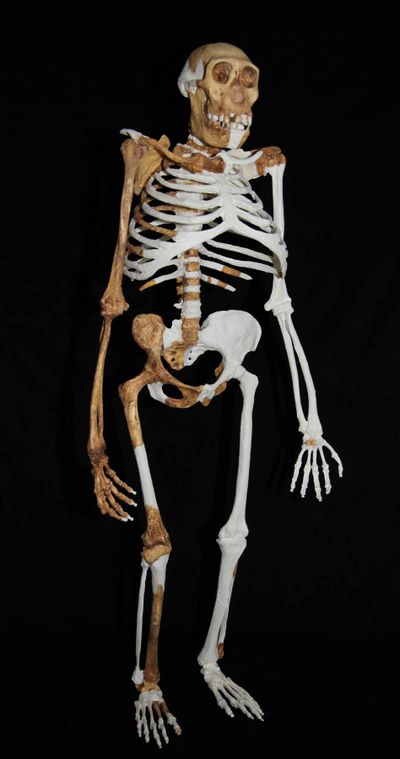A. sediba may be ‘missing link,’ researchers say

LOS ANGELES – With long arms, high shoulder blades and powerful fingers, the ancient creatures were built for climbing trees. But they also had long lower limbs, flat feet and a flexible lumbar spine that gave them a distinct evolutionary edge: They could cover long distances by walking upright on two legs.
After four years of intense analysis, a team of paleoanthropologists is making its most detailed case yet that a pair of ancient skeletons discovered in a grassy South African valley could represent the direct evolutionary link between modern humans and the family of human ancestors that includes the Australopithecus known as Lucy.
In a series of six papers published in Friday’s edition of the journal Science, the researchers argue that the “mosaic nature” of the Australopithecus sediba specimens makes them a strong candidate to be the “missing link,” the branch of Australopithecus that ultimately gave rise to the genus Homo, which includes Homo sapiens.
The skeleton fossils have so many human-like features “across the whole of the body that it must be considered, at the very least, a possible ancestor,” said Lee R. Berger, a paleoanthropologist at the University of the Witwatersrand in Johannesburg, South Africa, who discovered the fossils in 2008. Berger was senior author of all the new studies.
But not everyone accepts this view. Critics say the skeletons are not old enough to be the precursors to Homo. Others say the similarities can be chalked up to the diversity of early hominids, but that certain aspects of A. sediba’s anatomy make it an unlikely candidate for being our forebear.
At a minimum, the new details revealed in the papers are causing scientists to revise, or at least question, some long-held assumptions about the anatomical makeup of our extended evolutionary family. For example, though it was long believed that Australopiths had six lower vertebrae – one more than humans and at least two more than apes – it is now clear that they had the same number as humans: five.
The apelike boy and older woman who tumbled through a sinkhole and lay buried in a deep underground cave for nearly 2 million years have also given scientists a better view of how our early relatives walked. One of the papers focused entirely on the female’s lower limbs and reconstructed the mechanics of her motion.
By examining bone grooves and muscle attachments in the kneecap, thigh and lower leg bones and comparing them with those in humans and apes, the scientists were able to figure out that the roughly 4-foot-tall creature walked upright. But she probably did so with a peculiar gait marked by an inward rotation of the knee and hip, causing her narrow-heeled feet to twist slightly.
This type of motion is called hyperpronation, and in modern humans it’s considered a problem that needs correction. But the leg anatomy of this female suggests that A. sediba was built to walk in this manner, said Jeremy DeSilva, a functional morphologist at Boston University and lead author of that part of the analysis. The team wrote that it would need to examine more fossils before it could say whether the entire species walked the same way.
Berger said that if modern humans were to observe an A. sediba walking by, their attention would probably not be drawn to its legs. “What would be a great difference would be how it swung its long upper limbs during that walk and the shrugged-shoulder appearance of its upper body,” he said.
The researchers speculated that the animals spent their lives both in trees and walking on the ground.
In other aspects of the research, scientists reported that these specimens had jaws and teeth that are recognizably human. In earlier studies, researchers concluded, too, that the creature’s hands were capable of precise gripping.
The presence of several humanlike features has led Berger and others to suggest that A. sediba, which lived an estimated 1.78 million to 1.95 million years ago, may have been the species that evolved into the earliest members of the Homo genus.
But other paleoanthropologists have pointed out several problems with that thesis.
Ian Tattersall, paleoanthropologist and curator at the American Museum of Natural History in New York, said that A. sediba’s skull, ribs and parts of its pelvis were just too different for it to be a direct ancestor.
“In general, it doesn’t have the flavor of the genus Homo,” Tattersall said.